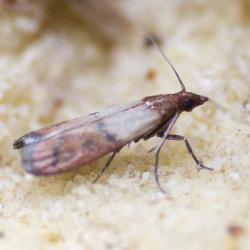One of the most frustrating household pests to deal with as a homeowner is the pantry moth. These bugs can make their way inside your home and go undetected, leading to a full-blown infestation in what seems like overnight.
Fortunately, there are several ways to prevent them from taking over your cupboards. Read on to learn all about pantry moths and how you can get an infestation under control.
Is This A Pantry Moth?
Pantry moths are winged insects with six legs and two antennae. They have an elongated oval shape and are a brownish beige color with a copper reddish color on their wings. Adult pantry moths are between 5/8 of an inch to 3/4 of an inch in length. These bugs are found all across the United States and, like other moths, are highly attracted to light sources.
Pantry moths feed on dried food products, commonly found inside pantries. Some of the foods they prefer include seeds, grains, nuts, pasta, and dried fruits. They also feed on dried pet food and powdered milk. Sometimes people find them feeding on candy, chocolate, and even dried spices. Other names for the pantry moth include the Indian meal moth, weevil moth, grain moth, and flour moth.
How Do Pantry Moths Find Their Way Into Homes?
Pantry moth infestations often happen without homeowners having a clue until it's already out of control. These moths are commonly in food production plants and warehouses where they store food before shipping it to your local grocery store. If pantry moths get into food sources, they can lay hundreds of eggs inside that go undetected as workers package food. The eggs will continue to develop in the contaminated food until they hatch and grow into full adult moths.
The full life cycle can take anywhere between one and ten months, and moths can quickly spread to other food items in your kitchen or storage areas if you don’t seal them properly. One of the telltale signs of an infestation, aside from seeing actual pantry moths flying around, is noticing webbing in the corners of your cabinets or shelving. As soon as you notice signs of these insects, it's important to eliminate them before they contaminate more of your food and make you and your family sick.
Five Effective Pantry Moth Prevention Tips
Pantry moths can be difficult to deal with, but there are several things you can do to prevent an infestation or stop it from getting worse. Try out these five prevention tips today:
- Inspect all dry food items as soon as you get home from the grocery store. Look for eggs, larvae, or webbing. Don't forget to check your pet food, too. Place items in a plastic bag and put them in the freezer for about a week to kill any eggs.
- Place sachets of bay leaves inside your cupboards. Bay leaves are a natural moth repellent.
- Store all food in airtight containers made of glass or plastic. Make sure lids are secure and choose options with screw tops or locks.
- Use white vinegar to clean food containers and cabinet shelving. Add peppermint, tea tree, or eucalyptus essential oil for added potency.
- Clean and vacuum out food storage areas regularly. If you notice pantry moths or their eggs, dispose of the vacuum bag in outdoor garbage. If you have a canister vacuum, wash it with hot water and soap.
When preventative measures and home remedies fail, it might be time to call a professional moth exterminator, like American Pest Solutions.
The Trick To Total Pantry Pest Control
Don't let pantry moths take over your kitchen cabinets. The professionals at American Pest Solutions have extensive experience in moth extermination and have been a trusted source of pest control in Western Massachusetts for over 100 years. Contact us today to learn more about our solutions and to schedule an appointment.

